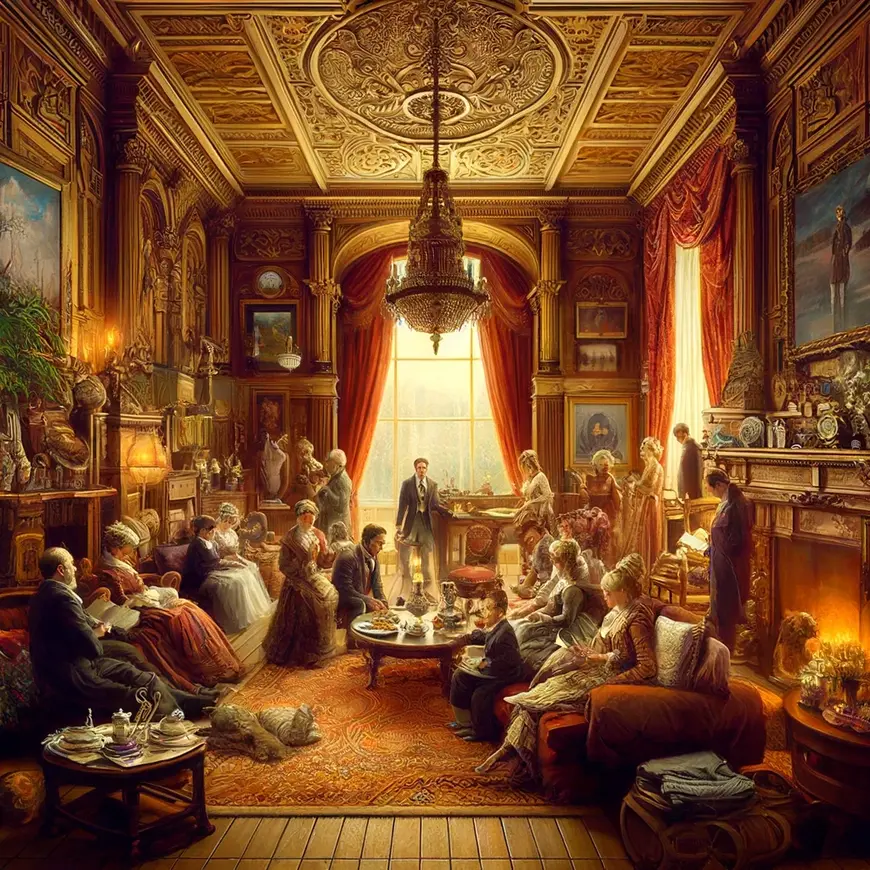A Multigenerational Epic: Buddenbrooks by Thomas Mann
What I think about Thomas Mann’s “Buddenbrooks”
I was captivated by Thomas Manns “Buddenbrooks,” which delves into the lives of a family. The novel traces the experiences of the Buddenbrook family across generations navigating through their triumphs and setbacks.
While reading I found myself forming a bond with the characters. Each family member carries their aspirations and challenges. The narrative illustrates how their circumstances evolve over time offering insight into how different generations confront adversity.
Manns prose is intricate and immersive painting a portrait of the familys existence within their backdrop. The storyline prompted reflections, on dynamics and the effects of time on individuals paths. “Buddenbrooks” stands as an account of a familys ascent and descent leaving an enduring impact, on my thoughts.
In the vast expanse of classic literature, Thomas Mann’s “Buddenbrooks” stands as a monumental epic that unfolds the saga of the Buddenbrook family over several generations. With prose as rich as it is intricate, Mann crafts a narrative that spans the realms of commerce, culture, and the inevitable march of time. Join us on a journey through the rise and fall of the Buddenbrooks, a family legacy marked by grandeur, struggles, and the inexorable passage of history.
Unveiling the Tapestry of Generations: The World of Buddenbrooks
Imagine a world where a family’s fate is intricately woven into the fabric of a changing society. “Buddenbrooks” immerses us in this world, where the Buddenbrook family navigates the shifting tides of the 19th and early 20th centuries in the northern German city of Lübeck. Mann’s prose invites us to witness the family’s ascent to prosperity, the complexities of their interpersonal relationships, and the inevitable decline of their once-sturdy empire.
The setting of “Buddenbrooks” is not merely a backdrop; it is a character in itself. Mann’s meticulous descriptions paint a vivid picture of Lübeck, a city that evolves alongside the Buddenbrooks. The atmosphere he creates is both nostalgic and reflective, echoing the changes in the family’s fortunes and the larger societal shifts of the time.

Characters in the Spotlight: A Panorama of Personalities
At the heart of “Buddenbrooks” is the Buddenbrook family, a cast of characters that spans several generations. Thomas, Tony, Christian, and Hanno are just a few of the figures who shape the family’s destiny. Each member of the family, with their distinct personalities and aspirations, becomes a vessel for readers to explore themes of ambition, societal expectations, and the complexities of familial bonds.
Themes of Commerce, Culture, and Family: Insights Explored
“Unraveling the tapestry of commerce, culture, and family,” Mann seems to say, as he delves into themes that resonate across time and generations. The theme of commerce is central to the narrative, as the Buddenbrooks build their legacy through their successful trading house. Mann’s exploration of commerce prompts readers to reflect on the interplay between business acumen, societal expectations, and the fragility of financial success.
Culture, with its artistic and intellectual dimensions, is another prominent theme in “Buddenbrooks.” Mann portrays the family’s relationship with the arts, literature, and societal refinement. The tension between cultural pursuits and the demands of practical life creates a narrative that is both thought-provoking and emotionally charged, encouraging readers to consider the role of culture in shaping individual identities and societal values.
Family, as the bedrock of the narrative, is a recurring motif in “Buddenbrooks.” Mann delves into the dynamics of familial relationships, the expectations placed on each generation, and the impact of individual choices on the family’s trajectory. The narrative prompts readers to contemplate the universal themes of legacy, loyalty, and the passage of time within the context of family life.
Prose as an Intricate Tapestry: Mann’s Writing Style
Thomas Mann’s writing style in “Buddenbrooks” is an intricate tapestry, a blend of detailed realism and philosophical introspection. His language is both elegant and complex, creating an atmosphere that is both immersive and intellectually stimulating. Mann’s prose is characterized by its keen observations of human nature, its exploration of societal shifts, and its nuanced portrayal of the inner lives of his characters.
The novel’s structure is meticulously crafted, with each chapter offering a snapshot of the Buddenbrooks’ lives at different points in time. Mann’s writing style mirrors the ebb and flow of the family’s fortunes, where moments of triumph and despair are punctuated by the intricacies of personal relationships and societal changes, creating a narrative that is both expansive and deeply introspective.
Timeless Relevance: Today’s Reflections
While “Buddenbrooks” is firmly anchored in its specific historical context, its exploration of commerce, culture, and family remains profoundly relevant in the contemporary world. In an era marked by changing societal norms, the complexities of familial relationships, and the pursuit of success, Mann’s examination of these themes offers a timeless perspective.
The theme of commerce continues to resonate, as individuals and families navigate the complexities of financial success and societal expectations. “Buddenbrooks” prompts readers to reflect on the enduring tension between material prosperity and the pursuit of personal fulfillment, a theme that remains relevant in today’s consumer-driven society.
Culture, in the context of artistic and intellectual pursuits, remains an essential theme. The narrative encourages readers to contemplate the role of culture in shaping individual identities and societal values, especially in a world where technology and globalization shape our cultural landscapes.
Family, as a cornerstone of human experience, remains a universal theme. “Buddenbrooks” prompts readers to consider the dynamics of familial relationships, the impact of individual choices on family legacies, and the enduring quest for connection and understanding within the context of family life.

Famous Quotes from “Buddenbrooks” by Thomas Mann
- “For the sake of a single verse, one must see many cities, men, and things.”
- This quote reflects on the necessity of wide-ranging experiences and observations for the creation of profound art. It suggests that depth in literature or poetry comes from a broad engagement with the world and understanding of different lives and perspectives.
- “A man’s dying is more the survivors’ affair than his own.”
- This poignant observation highlights the impact of death on the living. It suggests that the significance of a person’s death is primarily felt by those left behind, who must deal with the loss and its emotional aftermath, rather than the person who has died, for whom all experiences and sufferings have come to an end.
- “There is nothing more frightful than imagination without taste.”
- This quote criticizes unchecked imagination that lacks refinement or discernment. Mann suggests that creativity, when not tempered by taste or judgment, can lead to grotesque, absurd, or distasteful outcomes. It underscores the importance of aesthetic sensibility in artistic expression.
- “Solitude gives birth to the original in us, to beauty unfamiliar and perilous – to poetry. But also, it gives birth to the opposite: to the perverse, the illicit, the absurd.”
- Here, Mann explores the dual nature of solitude. On one hand, solitude can foster creativity, originality, and the birth of beauty in art and thought. On the other, it can also lead to the development of thoughts and desires that society considers perverse or unacceptable. This quote reflects the novel’s theme of the individual’s struggle with societal norms and the internal conflict between personal desires and external expectations.
- “What good would it do to shut your eyes to spoilt and sinning humanity? It does not make it any better.”
- This quote emphasizes the importance of facing reality and acknowledging human flaws and sins. Mann suggests that ignoring or denying the darker aspects of human nature does not change or improve them; instead, it’s important to confront and understand these aspects to foster compassion and empathy.
Trivia facts about “Buddenbrooks”
- Nobel Prize: Thomas Mann was awarded the Nobel Prize in Literature in 1929, in part due to his work on “Buddenbrooks.” The novel was specifically mentioned in the Nobel citation, highlighting its vivid portrayal of a North German merchant family and its significance in Mann’s body of work.
- Semi-autobiographical Elements: “Buddenbrooks” draws heavily from Thomas Mann’s own family history and experiences. The Mann family, like the Buddenbrooks, were a prominent family in Lübeck, and Thomas Mann used his personal insights and experiences to depict the decline of the family over generations with authenticity and depth.
- Debut Novel: “Buddenbrooks,” published when Mann was only 26 years old, was his first novel. Despite its length and complex narrative, the novel established Mann as a significant figure in German literature and set the stage for his illustrious literary career.
- Critique of Bourgeois Society: The novel is regarded as a critical exploration of the bourgeois society of the time. Mann meticulously depicted the values, aspirations, and eventual decline of the bourgeoisie, offering a subtle critique of its materialism and moral decay.
- Influence of Schopenhauer and Nietzsche: Mann’s interest in the philosophies of Arthur Schopenhauer and Friedrich Nietzsche is evident in “Buddenbrooks.” The novel explores themes of will, decadence, and the dichotomy between the individual’s desires and societal pressures, reflecting Mann’s engagement with these philosophical ideas.
- Decay and Disease Motif: The theme of physical decline and disease runs parallel to the moral and financial decline of the Buddenbrook family. Mann uses illness and deterioration as symbols of the family’s fading vitality and fortune, reflecting the broader themes of decay and decline.
- Detailed Food Descriptions: “Buddenbrooks” is known for its detailed and vivid descriptions of food, which serve not just as a backdrop but as a means to reveal character traits, social status, and shifts in societal norms. These descriptions are a rich aspect of Mann’s narrative technique.
- Impact and Legacy: The novel’s detailed portrayal of the decline of a family over four generations has made it a seminal work in the genre of family sagas. It has influenced numerous authors and works, contributing significantly to the literary exploration of family dynamics and societal change.
Final Thoughts: A Literary Panorama of Time and Change
“Buddenbrooks” is a literary panorama that invites readers to immerse themselves in the grandeur and decline of a family legacy. Thomas Mann’s narrative is a testament to the enduring power of literature to challenge our understanding of commerce, culture, and family, to invite us into the lives of a multigenerational cast of characters, and to prompt us to reflect on the timeless themes of societal shifts and familial bonds. Mann’s prose becomes a vessel through which readers can contemplate the complexities of success, the nuances of cultural identity, and the universal dynamics of family life. “Buddenbrooks” is a testament to the enduring relevance of themes that have fascinated readers for generations, and it invites us to navigate the currents of time and change with both introspection and appreciation
Reviews of other Works by Thomas Mann
Thomas Mann’s “Confessions of Felix Krull” — A Literary Carnival of Deception and Delight Thomas Mann, the maestro of German…
A Journey into Desire and Decay – A Review of Thomas Mann’s “Death in Venice” Mann’s Masterpiece of Eros and…
The Dark Charms: A Review of “Mario and the Magician” by Thomas Mann In Thomas Mann’s compelling short story “Mario…
A Majestic Journey Through Royalty – Thomas Mann’s “Royal Highness” Enter the opulent world of royalty and human nature with…
A Captivating Ascent to the Heights of Thought: “The Magic Mountain” by Thomas Mann My Takeaways from The Magic Mountain…




